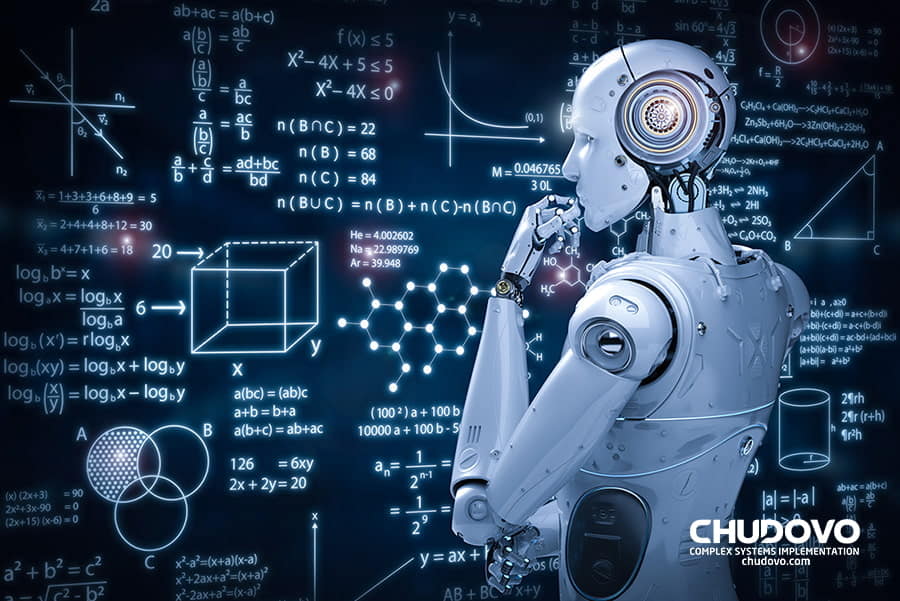From Concept to Reality: How to Develop an Effective AI System
According to Statista, the global artificial intelligence (AI) software market will reach $126 billion by 2025. Therefore, it is not surprising that many enterprises and organizations are eager to learn how to program artificial intelligence. In this paper, we will look at the stages of developing an AI system, including understanding the concept, choosing programming languages, and building a team of specialists.
We will also discuss the various applications of AI in software development, the ethical considerations involved in AI development, and the importance of testing and evaluation. AI development services can greatly simplify the implementation of AI in your software, which is why you need to understand the importance of selecting between outsourcing and your team.
Table of contents
- What Is AI?
- Why Is It Necessary to Create an AI?
- What Programming Languages Can Be Used?
- Where Can AI Be Used in Software Development?
- What Specialists Are Needed in Order to Develop an AI System?
- How Does AI Software Learns to Make AI Software?
- How to Develop AI?
- Nearshore Software or Your Own?
- Conclusion
- FAQ

What Is AI?
Artificial intelligence (AI) is a rapidly growing field of computer science that aims to create machines with the ability to think and learn like humans. The goal is to develop intelligent systems that can perform tasks that would typically require human intervention, such as analyzing and processing data, making predictions, and solving complex problems. The development of AI involves the creation of algorithms that can simulate human intelligence, allowing machines to learn from experience and adapt to new situations.
In recent years, AI has become increasingly important in finance, healthcare, and transportation. For example, AI algorithms are used in financial trading to analyze market trends and make predictions about future performance. In healthcare, AI is being used to develop new treatments and improve patient outcomes by analyzing large amounts of medical data. In transportation, AI is being used to develop self-driving cars that can navigate complex environments and make decisions in real time.
Why Is It Necessary to Create an AI?
The creation of AI technology has become increasingly necessary due to its potential to transform the world as we know it. There are numerous reasons why creating artificial intelligence is essential, and some of these reasons include:
1. Enhanced Processing and Analytical Capabilities
One of the primary reasons why it is necessary to create AI is that it has the potential to process and analyze data much faster and more accurately than humans. This makes AI ideal for applications such as data analysis, image recognition, and natural language processing. With this technology, we can make sense of vast amounts of data that would otherwise be impossible or extremely time-consuming to analyze.
2. Solving Complex Problems
Another reason why it is crucial to create artificial intelligence systems is that they can help us solve complex problems that would be difficult or impossible for humans to solve on their own. For example, AI can be used to develop new pharmaceuticals, design more efficient energy systems, and even predict and prevent natural disasters. With AI, we can tackle some of the most challenging issues facing society today.
3. Revolutionizing Industries
Finally, the creation of AI is necessary because it has the potential to revolutionize numerous industries, leading to increased efficiency and productivity. This could result in significant economic growth and improved quality of life for people around the world. Some of the industries that could be transformed by AI include healthcare, finance, transportation, and manufacturing.
What Programming Languages Can Be Used?
Before asking how to create an AI, you need to have an idea of what programming languages you can use. Each of these languages has a large science community that allows you to find the information or advice you need during development.
Python
Python is an incredibly popular language for AI development due to its simplicity, readability, and availability of numerous libraries. In addition, Python has a vast and growing community of developers who create and contribute to open-source projects, making it an attractive choice for developers. With its wide range of tools for machine learning, natural language processing, and computer vision, Python has become the go-to language for many AI applications.
Furthermore, Python’s ease of use and versatility make it an ideal choice for beginners. Its simple syntax allows developers to focus on the logic of their code rather than getting bogged down in the details of the language itself. Additionally, the large number of libraries available for Python means that developers don’t have to reinvent the wheel every time they start a new project.
Java
Java is a programming language that has gained popularity in recent years due to its ability to build complex AI systems. Its high-level nature allows for easier development and deployment of AI applications. Additionally, Java has an extensive ecosystem of libraries and frameworks that can be utilized for AI development, including TensorFlow, Keras, and PyTorch. These libraries enable developers to create neural networks, machine learning models, and natural language processing tools. Moreover, Java’s cross-platform capabilities allow for AI applications to be run on a wide range of devices, making it a versatile choice for developers.
C++
C++ is a popular programming language that is widely used in artificial intelligence development. C++ is known for its speed and efficiency, making it a great language for building AI applications that require large amounts of processing power. In the field of AI, C++ is used for a variety of applications, including gaming and robotics. In gaming, C++ is used to develop AI algorithms that control non-player characters and simulate realistic behavior. In robotics, C++ is used to develop software that controls the robot’s movements and decision-making processes. C++ is also used in other areas of AI, such as natural language processing and computer vision.
R
R is a programming language and software environment used for statistical computing and graphics. It is widely used by data analysts and scientists to develop and implement AI applications that involve data analysis and visualization. Moreover, R is an open-source language that enables users to contribute to developing and improving the language, making it a dynamic and constantly evolving tool. Additionally, R has a large and active community of developers and users who share knowledge and collaborate on projects, making it an excellent resource for those looking to expand their skills and expertise in the field of data science.

Where Can AI Be Used in Software Development?
Artificial intelligence can be used in various ways in software development. One of the most promising applications is automating the process of finding and fixing bugs. By using machine learning algorithms to analyze code and identify patterns, AI can help developers identify and fix bugs faster and more accurately than ever before. To do this, you only need to understand how to code an AI.
AI can also be used to improve the speed and accuracy of software testing. By automating the testing process and using algorithms to identify potential issues, developers can ensure that their code works as expected before it is published.
In addition, AI can be used to improve the efficiency of the software development process as a whole. By analyzing data from past projects and identifying areas for improvement, AI can help developers work more efficiently and effectively.
However, it is important to note that AI is not a panacea for all software development problems. There are still many tasks that require human participation and creativity, and AI should be used as a tool to expand human capabilities, and not completely replace them.
What Specialists Are Needed in Order to Develop an AI System?
The development of an AI system requires a team of experts with a range of specialized skills. Each team member is essential to the success of the project, and collaboration between them is vital. Also, the presence of an editorial team will allow you to find potential errors.
- Data scientists are responsible for collecting, cleaning and analyzing the data used to train the AI system. They use statistical and machine learning methods to discover patterns and insights that can be used to improve the performance of an AI system.
- Machine learning engineers are responsible for designing and implementing the algorithms that underpin an AI system. They use mathematical models to teach the system to recognize patterns and make predictions.
- Software developers are responsible for creating the code that runs the AI system. They use programming languages such as Python and Java to architect the system and ensure it runs efficiently.
- Domain software engineers are people who have deep knowledge of the industry or sector in which the AI system will be used. They provide valuable insight into business requirements and help ensure that the system meets the needs of its users.
- Ethicists have a responsibility to ensure that an AI system is developed and used in an ethical and responsible manner. They help identify potential biases and ethical issues that may arise during the development process and work to mitigate these risks.
How Does AI Software Learns to Make AI Software?
Artificial intelligence software is usually created by programmers who write code that can process data and make decisions based on that data. However, there are also methods for AI software to learn how to build other AI software. These methods are known as “machine learning” and “deep learning”.
Machine learning involves training an AI system using large amounts of data. An AI system learns from data and develops rules or patterns that allow it to make decisions or make predictions. For example, an AI system can be trained in image technology. This can be done on a dataset of cat and dog images and learn to distinguish between them.
Deep learning is a type of machine learning that involves using neural networks to learn from data. A neural network is a complex system of interconnected nodes capable of analyzing and processing information. Deep learning is able to learn more complex patterns and relationships than traditional machine learning methods.
Another way for AI software to learn how to build other AI software is through “genetic programming”. This includes creating a population of AI programs and using natural selection to evolve them over time. The most successful programs are allowed to reproduce and create new generations of AI programs that are more tailored to the task at hand.
Finally, “neuroevolution” includes the development of neural networks that can learn to perform certain tasks, such as image recognition or language translation. This method is similar to genetic programming but focuses on the development of neural networks rather than entire programs.

How to Develop AI?
These few simple steps will help you understand exactly what it takes to develop AI software.
Step 1. Understanding the Concept
When developing an AI system, it is essential to have a clear understanding of the concept or problem it is intended to solve. This involves defining the scope of the difficulty, identifying any challenges or limitations, and determining the expected outcome or performance metrics.
Without a solid understanding of the concept, it can be difficult to develop an effective AI system. This can lead to wasted time and resources, as well as suboptimal results. To ensure a successful AI development process, it is important to have experts in the field working on the project. These experts should have knowledge and experience in the specific issue domain, as well as expertise in AI development techniques.
By taking the time to gain a deep understanding of the problem and its context, AI developers can create an effective and innovative software solution that meet the needs of users and stakeholders.
Step 2. Development and Implementation
During the development and implementation phase of an AI project, it is important to ensure that the system behaves as intended. Knowledge about how to program an AI can help with this. This includes testing and validating the system against various inputs and use cases. It’s also important to monitor system performance over time to make sure it continues to perform as intended.
One of the key tasks at this stage is to ensure that the AI makes ethical and impartial decisions. Bias can enter AI systems in many ways, such as through the data used to train the system, or through the algorithms used to make decisions. Careful attention must be paid to these factors in order for the system to make fair and unbiased decisions.
Another significant point at this stage is scalability. Since the system is implemented in the real world, it may need to process large amounts of data and queries. Ensuring that the system can scale to meet these requirements is essential to its success.
In general, the development and deployment phase is a critical step in the AI development process. With meticulous attention to detail and a focus on ethics and scalability, AI systems can be built that are efficient and beneficial to everyone.
Step 3. Testing and Evaluation
Testing and evaluation are essential components of the artificial intelligence (AI) system development process. These processes help ensure the safety, reliability, and efficiency of AI systems.
During development, AI systems must be thoroughly tested in various scenarios to ensure that they function as expected. This includes testing for accuracy, reliability, and scalability. In addition to testing, evaluation is necessary to evaluate the performance of AI systems. Evaluations can be made using various metrics such as accuracy, recall, and F1 score. These metrics help evaluate system performance and identify areas for tech improvement.
It is important that testing and evaluation be continuous processes, as AI systems are constantly evolving. Regular testing and evaluation help ensure system safety and performance throughout its life cycle. In general, testing and evaluation are essential components of the AI systems development process. They help to ensure the correct functioning of the system, its safety, reliability, and efficiency.
Step 4. Maintenance and Improvements
When developing AI, it is essential to remember that over time the system will need maintenance and improvements. This is because the AI will inevitably encounter new situations and data that it has not seen before, which can lead to errors or less accurate results.
To solve this problem, it is significant to have a plan for continuous maintenance and improvement of AI. This may include tweaking the system to monitor AI performance, identify areas where it is having difficulty, and make adjustments to improve its accuracy in transforming industries.
Also, it is important to have a process to update the AI with new data and information as it becomes available. This could include teaching the AI about new data sets or adjusting its algorithms to account for new variables. By implementing a robust maintenance and improvement plan, developers can ensure that their AI systems continue to perform at a high level over time, benefiting both users and stakeholders.

Certified engineers
Convenient rates
Fast start
Profitable conditions
Agreement with
EU company
English and German
speaking engineers
Nearshore Software or Your Own?
Before asking how to make an artificial intelligence program, you need to understand how you want to develop AI software. You can hire an outsourcing company or do it yourself. Here’s the comparison table again using the different criteria for deciding between nearshore software and building your own:
| Criteria | Veteran nearshore Software | Building Your Own |
| Cost | Often cheaper than hiring in-house developers. Can save money on hiring, infrastructure, and ongoing maintenance costs. | It can be expensive as you need to hire developers, invest in infrastructure, and pay for ongoing maintenance. |
| Quality | Quality can be high if you work with a reputable nearshore development company. Frequently have a team of experienced developers and a proven track record of delivering high-quality software. | Quality depends on the skills and experience of the developers you hire. |
| Communication | Nearshore companies typically have a good command of English and are in a similar time zone, making communication easier. | Communication can be more challenging if you are working with remote developers in different time zones. |
| Control | You have less control over the development process when working with a nearshore team. Must rely on the development company to manage the project and deliver the software according to your specifications. | You have more control over the development process when building your own software. Can oversee the project from start to finish, ensure that it is developed to your exact specifications, and make changes along the way. |
By considering these factors, you can make an informed decision on whether to use nearshore software or build your own software, depending on your unique needs and requirements.

Conclusion
In conclusion, the development of artificial intelligence has become increasingly necessary due to its potential to transform the world as we know it. Understanding how to build an AI can help you optimize your work. With the ability to process and analyze data much faster and more accurately than humans, AI is ideal for applications such as data analysis, image recognition, and natural language processing. The creation of AI is essential to solving complex problems that would be difficult or impossible for humans to solve on their own. However, it is important to note that AI is not a panacea for all software development problems. There are still many tasks that require human participation and creativity, and AI should be used as a tool to expand human capabilities, and not completely replace them.
FAQ
Answering questions will help you get rid of doubts and questions that might arise while reading.
How to create artificial intelligence systems?
To create an artificial intelligence system, you will need to use a combination of machine learning algorithms, data analysis techniques, and programming skills. Some general steps involved in building an AI system include:
- Define the problem you want to solve with the AI system
- Data collection and preparation for AI system training
- Choosing a machine learning algorithm and training an AI system on prepared data
- Evaluate the performance of the AI system and make the necessary adjustments.
- Deploy an AI system in a production environment and track its performance over time.
What are some common pitfalls when building AI?
One of the common mistakes in building AI is overfitting the model. This happens when the model is trained too much on a particular dataset and cannot generalize to new data. Another pitfall is underestimating the importance of data quality. For AI training, you need to give only reliable data, otherwise, the final results will not be good enough.
How long does it take to create AI?
The time it takes to create an AI may vary depending on the complexity of the AI and the experience of the developer. Building a simple chatbot can only take a few days while building a complex machine-learning model can take months or even years. This must be understood before how to make a AI.
What are the ethical considerations when creating AI?
Ethical considerations when building AI include issues such as data privacy, algorithmic bias, and the impact on society at large. Developers must ensure that the data used to train AI is collected in a legal and ethical manner and that AI does not perpetuate existing biases or create new ones. Developers must also consider the potential impact of AI on individuals and society and take steps to mitigate any negative impacts.
If you are thinking of starting a new AI&ML project, contact us now!




